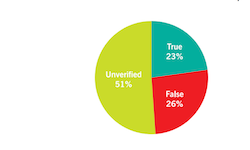I recently completed a research project that saw me spend several months studying how news organizations handle online rumors and unverified claims. I also examined best practices for debunking online misinformation. This work, which was the focus of my fellowship with the Tow Center for Digital Journalism at Columbia University, is collected in a report I published this week.
It examines the human factors that drive rumors, the challenge of debunking online misinformation, and it provides a data-driven look at the bad practices that cause news websites to spread dubious rumors, and to play a role in disseminating misinformation. Identifying the challenges and problems in this area also helped me formulate a set of recommendations for newsrooms. This guidance can help journalists do a better job of offering debunkings that can spread the truth.
Below is an excerpt from the report that includes recommendations for offering effective debunkings. I welcome suggestions and feedback, and I also encourage more journalists to include an element of debunking in their work. It’s all of our job to help the truth to spread.
Recommendations for Newsrooms: Debunking
Don’t be part of the problem.
It bears repeating that news organizations should not be in the business of spreading misinformation and dubious rumors. News sites that are perceived to be wastelands of unverified information will not be effective debunkers. They will simply not be trusted.
Move quickly.
False information becomes harder to dislodge the longer it goes unchallenged. The more that people see an incorrect headline, image, video, etc., in their social media feeds and emails, the more they are likely to believe it.
The first step is to be more active at flagging unconfirmed information when it begins to spread. Communicate what isn’t known and help people understand they need to apply a level of skepticism. When something is verified as false, be fast and aggressive in getting it out.
Don’t be negative or dismissive.
As the skeptics interviewed for this paper said, the goal is to debunk an idea or claim, not the person who may be sharing it. Debunkings should not make people feel stupid or attacked. Research has found that “conciliatory rebuttals were more effective than were inflammatory ones,” according to DiFonzo and Bordia in Rumor Psychology.
Provide a counter narrative.
This is one of the most important debunking strategies. The goal is to replace the existing narrative in a person’s mind with new facts. It’s more effective than a piecemeal approach to refuting rumors. Humans are attracted to stories, not a recitation of information.
Anthony Pratkanis, a psychologist at the University of California, Santa Cruz, told The Boston Globe that a denial alone isn’t effective. “The more vivid that replacement is, the better,” Pratkanis said. Journalists should use all the storytelling tools available to make a debunking compelling and persuasive. Don’t be a spoilsport denier—tell a great story.
Keep it simple.
Journalists are sometimes guilty of overkill. We think that laying out all the facts in detail is an effective way to convince someone that they are misinformed. The reality is that misinformation often takes hold because it is communicated in a simple way, or through powerful phrases (i.e., “rumor bombs”). A debunking must be equally efficient. “A simple myth is more cognitively attractive than an over-complicated correction,” according to The Debunking Handbook [PDF]. “The solution is to keep your content lean, mean and easy to read.” If people have to expend too much processing-power to grasp your point and evidence, they will retreat to what they already know.
Understand the role of emotion and passion in driving shares and traffic.
In a 2012 paper, a group of researchers, including the authors of The Debunking Handbook, outlined the role of emotions in helping information propagate:
“Stories containing content likely to evoke disgust, fear, or happiness are spread more readily from person to person and more widely through social media than are neutral stories.” Rumors and hoaxes often appeal to people’s emotions, as well as their existing beliefs and fears. Debunking should therefore also aim to evoke emotion in readers. (But to do so in a genuine, rather than manipulative, way.)
Find the right source(s).
Some of the most powerful purveyors of misinformation are people who passionately believe the claim. False information also spreads when people who have standing in particular communities give it authority and visibility.
“Accordingly, the most effective ‘misinformers’ about vaccines are parents who truly believe that their child has been injured by a vaccine,” according to a 2012 paper “Misinformation and Its Correction: Continued Influence and Successful Debiasing.”
Another 2012 paper from Brendan Nyhan and Jason Reifler, “Misinformation and Fact-checking: Research Findings from Social Science,” outlined the important role sources play in communicating information:
A vast literature in psychology and political science has shown that statements are frequently more persuasive when they come from sources that are perceived as knowledgeable, trustworthy, or highly credible. Conversely, people are less likely to accept information from a source that is perceived as poorly informed, untrustworthy, not sharing the same values, etc.
Journalists need to think about how they can buttress a debunking through sourcing. Whenever possible, find a member of the community in question to voice the correct information. His or her words and presence will help reach the people who are most likely to suffer from the backfire effect.
Express in the positive.
Try to limit association with the incorrect information. The authors of The Debunking Handbook offer a diagram of an effective approach for presenting the correct information in a way that minimizes repeating misinformation:
Make it visual.
Visual presentation of information can help people get past biases and instead focus on the information being communicated. “Graphics appear to be an effective means of communicating information, especially about trends that may be the subject of misperceptions (the state of the economy under a given president, the number of casualties in a war, etc.),” wrote Nyhan and Reifler.
Experiment.
The above is a summary of the best current advice regarding debunking …. Some suggestions have years of research to back them up. Others have yet to be tested experimentally, let alone in newsrooms.
This leads to perhaps the most important task for journalists: experiment. Digitally savvy journalists and news organizations must dedicate resources to testing and iterating on different debunking (and rumor reporting) approaches. By testing different story formats, we can collectively gather additional insight into what works.







